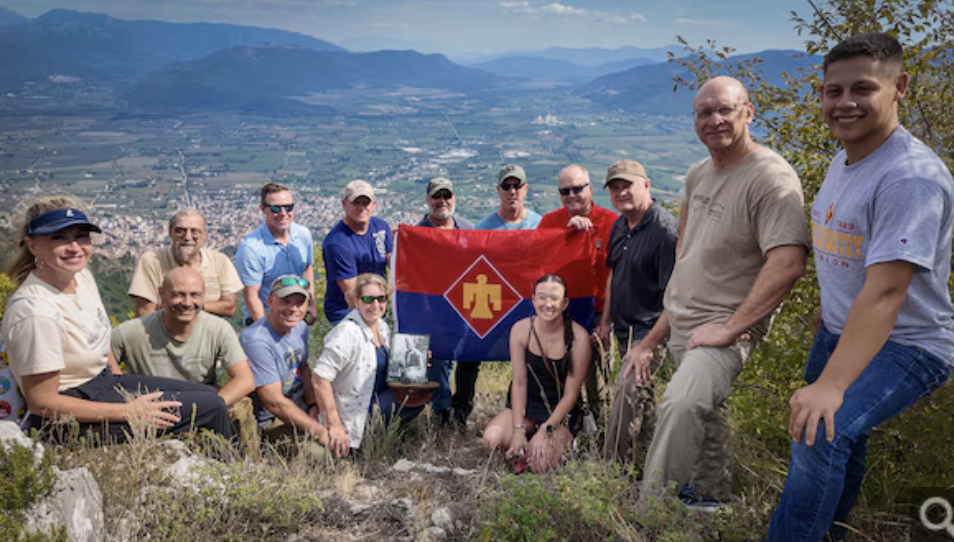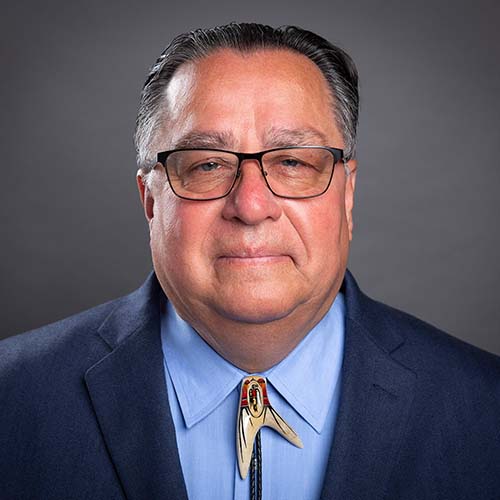
- Details
- By Chickasaw Nation Media
In September 1943, a major Allied offensive launched on the southwest Italian coast off the Tyrrhenian Sea proved successful in securing a beachhead despite fierce German resistance. It was the first step in liberating the country.
Eighty-two years later, the Chickasaw Nation has financed construction of a commemorative monument in honor of the 50 First American tribes who served in the 45th Infantry Division that took part in the invasion.
Their landing site was in Salerno, Italy. The monument site is approximately 25 miles south in Paestum, Italy, a major ancient Greek city.
A “Freedom for Italy” bulletin describes the monument, saying, “(It) is a 10-foot-tall obelisk marked with a Thunderbird, symbol of the 45th Division, (with) a memorial message and a map of other locations to be included in the new Thunderbird Trail which will trace the division’s journey through Italy, France, and Germany. The monument is in a park alongside monuments to other units that landed in Paestum south of Salerno in September 1943.”
Oklahoma State University professor Dr. David D’Andrea serves as the Thunderbird Trail’s historical adviser.
“We’re building a pathway to record where the 45th passed, from Sicily to mainland Italy, southern France and all the way to Germany,” D’Andrea was quoted as saying.
Maj. Gen. Brad Bowlin, commander of the 36th Infantry Division based in Austin, Texas, which also participated in the September 1943 landing, sent his regards in a message.
“Today, we honor not only the bravery of the 36th Infantry Division, but also the resilience and spirit of the Italian people,” Bowlin said.
“It is my solemn duty to carry forward the memory of those who came before us. We are humbled to walk in their footsteps, to remember their sacrifice and to strengthen the bond of friendship that began here in Paestum,” Bowlin said.
The Freedom for Italy release says the American troops in the 36th Division were the first to land on the mainland of Italy during the Second World War and “the division was to play a prominent role in the Italian campaign.”
The 36th Division was transferred out of Italy to join the Allied invasion of southern France in August 1944.
The 45th Division subsequently fought at Anzio, Italy, and was also transferred for the invasion of southern France. It eventually participated in the liberation of Dachau concentration camp and later occupied Munich, Germany.
More Stories Like This
Native News Weekly (August 25, 2024): D.C. BriefsUS Presidents in Their Own Words Concerning American Indians
Oral History Project Announces 14th Stop in Portland, Oregon: NABS Continues to Gather Crucial Stories Across Indian Country
Celebrating Veterans Day: Native Americans Serve in the Military at the Highest Rate of Any Group
Help us tell the stories that could save Native languages and food traditions
At a critical moment for Indian Country, Native News Online is embarking on our most ambitious reporting project yet: "Cultivating Culture," a three-year investigation into two forces shaping Native community survival—food sovereignty and language revitalization.
The devastating impact of COVID-19 accelerated the loss of Native elders and with them, irreplaceable cultural knowledge. Yet across tribal communities, innovative leaders are fighting back, reclaiming traditional food systems and breathing new life into Native languages. These aren't just cultural preservation efforts—they're powerful pathways to community health, healing, and resilience.
Our dedicated reporting team will spend three years documenting these stories through on-the-ground reporting in 18 tribal communities, producing over 200 in-depth stories, 18 podcast episodes, and multimedia content that amplifies Indigenous voices. We'll show policymakers, funders, and allies how cultural restoration directly impacts physical and mental wellness while celebrating successful models of sovereignty and self-determination.
This isn't corporate media parachuting into Indian Country for a quick story. This is sustained, relationship-based journalism by Native reporters who understand these communities. It's "Warrior Journalism"—fearless reporting that serves the 5.5 million readers who depend on us for news that mainstream media often ignores.
We need your help right now. While we've secured partial funding, we're still $450,000 short of our three-year budget. Our immediate goal is $25,000 this month to keep this critical work moving forward—funding reporter salaries, travel to remote communities, photography, and the deep reporting these stories deserve.
Every dollar directly supports Indigenous journalists telling Indigenous stories. Whether it's $5 or $50, your contribution ensures these vital narratives of resilience, innovation, and hope don't disappear into silence.
 The stakes couldn't be higher. Native languages are being lost at an alarming rate. Food insecurity plagues many tribal communities. But solutions are emerging, and these stories need to be told.
The stakes couldn't be higher. Native languages are being lost at an alarming rate. Food insecurity plagues many tribal communities. But solutions are emerging, and these stories need to be told.
Support independent Native journalism. Fund the stories that matter.
Levi Rickert (Potawatomi), Editor & Publisher
